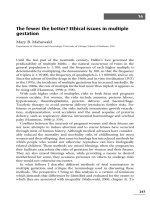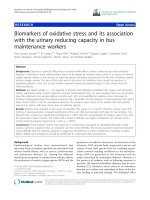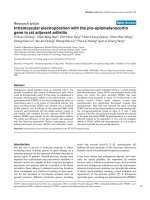How should china deal with the patent related issues in technical standardization
Bạn đang xem bản rút gọn của tài liệu. Xem và tải ngay bản đầy đủ của tài liệu tại đây (951.53 KB, 186 trang )
HOW SHOULD CHINA DEAL WITH THE PATENT- RELATED
ISSUES IN TECHNICAL STANDARDIZATION
ZOU AYUAN
(Juris Master (Hons.), Renmin University of China)
A THESIS SUBMITTED
FOR THE DEGREE OF LL.M.
FACULTY OF LAW
NATIONAL UNIVERSIYT OF SINGAPORE
2009
ACKNOWLEDGEMENTS
Foremost, I would like to express my sincere gratitude to my supervisor Prof.
Robert Ian McEwin, for his continuous support of my research study, for his
immense knowledge, patience and enlightening teaching method. His
encouragement and valuable guidance from the initial to the final stage
enabled me to develop a sound understanding of the research subject. His
detailed review and constructive suggestions provided a good basis for the
present thesis. I could not have imagined the completion of my thesis without
him.
Besides my supervisor, I would like to thank my NUS law school lecturers,
Prof. Ng-Loy Wee Loon for Intellectual Property Law, Prof. Alan Tan and Prof.
Andrew Simester for Graduate Research Seminar. My interest in the research
subject was illumined during their interactive lectures and my capabilities in
legal research were cultivated under their guiding hands. They not only
shared their knowledge and their first-hand experience in research studies
with me, but also inspired me to formulate my own way of thinking and
analyzing, which is the essential ingredient to my thesis.
I am deeply grateful to the best friends I met in NUS, Ms Huang Yan and Ms
Lin Lin, the two remarkably talented PhD fellows and also my sweetest sisters
in Singapore. It was our precious friendship that helped me through those
gloomy days during my research time. It was so wonderful to know that I was
not fighting alone in this seemingly endless battle of research study and
thesis writing.
i
My loving thanks also go to Mr Li Bin, who as a boyfriend, a fiancé and now a
husband witnessed the entire journey of my research study and spiritually
inspired me all the time. I had the most fruitful years with him by my side,
harvesting in the field of both academy and life.
Last but not least, I owe my deepest gratitude to my parents, the most perfect
father and mother I could imagine in this world, who spare no effort to provide
the best environment for me to grow up and unconditionally support me
throughout my life.
ii
TABLE OF CONTENTS
SUMMARY……………………………………………………………….....vii
GLOSSARY………………………………………………………………….ix
INTRODUCTION .................................................................................. 1
CHAPTER I THE SIGNIFICANCE OF STANDARDS AND
CHINESE STANDARDIZATION ................................... 5
I.1
A BRIEF INTRODUCTION OF STANDARDS ............................................ 5
I.2
THE CLASSIFICATIONS OF STANDARDS AND STANDARD-SETTING
ORGANIZATIONS ............................................................................... 8
I.3
BENEFITS AND DISADVANTAGES OF STANDARDIZATION .................... 13
I.3.1 Benefits of Standardization ................................................. 13
I.3.2 Disadvantages of Standardization....................................... 14
I.4
THE RELATIONSHIP BETWEEN ICT STANDARDS AND PATENTS ......... 17
I.5
THE CURRENT STANDARDIZATION IN CHINA AND THE CHALLENGES
IT IS FACING ................................................................................... 21
I.5.1 Current Standardization Environment in China ................... 21
I.5.2 Challenges Chinese Standardization Is Facing ................... 23
CHAPTER II THE PATENT-RELATED ISSUES IN
INTEROPERABILITY STANDARDIZATION AND
THE PRIVATE-SECTOR REGULATIONS IN THE
FORM OF SSO IP POLICIES – LESSONS MAINLY
FROM THE US AND INTERNATIONAL SSOS ...........26
II.1
THE HORIZONTAL RELATIONSHIP OF PATENTS INCLUDED IN A
STANDARD .................................................................................... 28
iii
II.1.1 The Concept of ‘Essential Patents’ ..................................... 28
II.1.2 The Legal Implications behind ‘Essential Patents’ – A
Normative Analysis ............................................................. 33
II.1.3 China’s DTV Standardization and Its ‘Essential Patents’
Analysis .............................................................................. 37
II.2
THE MONOPOLISTIC PATENT EXPLOITATIONS IN STANDARDIZATION
AND THE PROPER SSO IP POLICIES ............................................... 43
II.2.1 Typical Cases and Examples from the US .......................... 46
II.2.2 Patent Disclosure Obligations in Standardization as
Required by SSOs IP Policies............................................. 54
II.2.2.1 Justifications of Patent Disclosure in SSOs IP Policies55
II.2.2.2 The Scope of Patent Disclosure in Standardization.... 57
II.2.2.3 Disclosure Obligations Regarding Pending Patent
Applications................................................................ 60
II.2.2.4 When and Based on Whose Knowledge to Disclose . 64
II.2.2.5 Disclosure Obligations Concerning Withdrawals ........ 70
II.2.3 Patent Licensing Obligations in Standardization as
Required by SSOs IP Policies............................................. 72
II.2.3.1 The Relationship Between Patent Disclosure and
Patent Licensing obligations in SSOs IP Policies ...... 72
II.2.3.2 Royalty Free (“RF”) Licensing Obligations.................. 75
II.2.3.3 Reasonable and Nondiscriminatory (“RAND”)
Licensing Obligations ................................................. 77
II.2.4 Conclusions ........................................................................ 82
CHAPTER III THE PUBLIC-SECTOR REGULATIONS ON THE
PATENT-RELATED ISSUES IN STANDARDIZATION
iv
AND THE LEGAL ENFORCEABILITY OF SSOS IP
POLICIES – MAINLY IN THE CONTEXT OF
CHINESE LAW.............................................................83
III.1 THE APPLICATION OF CONTRACT LAW AS REGARDS SSOS IP
POLICIES AND PATENT-RELATED ISSUES IN STANDARDIZATION ......... 85
III.1.1 The Nature of SSOs IP Policies .......................................... 85
III.1.1.1 The Autonomy Theory in Analyzing SSOs IP Policies86
III.1.1.2 The Contract Theory in Analyzing SSOs IP Policies.. 87
III.1.2 A Few Noteworthy Aspects Applying Contract Law to
Enforce SSOs IP Policies.................................................... 91
III.1.3 Limitations of Enforcing SSOs IP Policies as Contracts ...... 95
III.2 THE APPLICATION OF IP LAW AS REGARDS SSOS IP POLICIES AND
PATENT HOLDUPS IN STANDARDIZATION ......................................... 99
III.2.1 An Introduction of Chinese Patent Laws............................ 100
III.2.2 Doctrine of Patent Misuse ................................................. 104
III.2.2.1 The Originality of the Doctrine of Patent Misuse –
Lessons from the US .............................................. 104
III.2.2.2 Discussions of Patent Misuse in Context of Chinese
Patent Laws ............................................................ 107
III.2.2.3 Proposed Patent Misuse Regulations in Chinese
Patent Laws and Their Applications in
Standardization....................................................... 110
III.2.2.4 The Strengths and Limitations of Doctrine of Patent
Misuse in Standardization ....................................... 116
III.2.3 Compulsory Licensing ..................................................... 118
III.2.3.1 A General Introduction of Compulsory Licensing..... 118
III.2.3.2 Applicability of Compulsory Licensing Provisions in
v
the Patent Law of China.......................................... 120
III.3 THE APPLICATION OF ANTIMONOPOLY LAW IN STANDARDIZATION .. 124
III.3.1 A Brief Introduction of Antimonopoly Law of China............ 126
III.3.2 Condemning Monopolistic Exercises of Patent Rights as
‘Abuse of A Dominant Market Position’ ............................. 129
III.3.2.1 The Identification of ‘Dominant Market Positions’ by
Chinese Antimonopoly Law..................................... 129
III.3.2.2 The Relationship Between IP Law and Competition
Law – Discussions and Analysis Mainly from the U. 134
III.3.2.3 Determining Whether A Patentee’s Manipulative
Exploitation of His Patent Right in Standardization
Constitutes ‘Abuse of Dominant Market Positions’ in
Context of Chinese Antimonopoly Law.................... 137
III.3.2.4 The Proposed Application of Antimonopoly Law of
China in Patent Disclosure in Standardization –
Lessons from the US .............................................. 143
III.3.5 Conclusion ........................................................................ 148
CONCLUSIONS ................................................................................ 149
RECOMMENDATIONS ..................................................................... 156
BIBLIOGRAPHY……………………………………………………….....xvii
vi
SUMMARY
Technical standardization in the field of information and computer technology
becomes gradually prevalent in the high-tech era. Technical standard setting,
which enables interoperability among diverse devices or equipments, has
been proven to be efficient and effective in fostering technological
development and benefiting end users. As a standard setting process usually
invites a group of competitors in the relevant industry to discuss future
cooperation and even profit distribution arrangements, private standardization
conducted on a voluntary basis has always been a concern in the eyes of
antitrust and competition laws. Meanwhile, it has occurred to standardization
promoters that patented technologies, which are inevitably involved in
technical standardization nowadays, have posed a great threat to the wide
adoption and the procompetitiveness of the standards formulated.
The patent-related issues arise in private technical standardization, either
conducted through formal standard setting organizations or by loose joint
ventures, mainly in the following two aspects: first, the collusive interactions
of patents included in a standard may preclude or restrict normal competition;
second, the monopolistic exploitations of exclusive patent rights may prevent
the wide adoption of the standard or may cause unreasonably high royalties
to be charged to interested standard adopters. Both of these two types of
patent-related issues will end up distorting market competition and ultimately
depriving benefits from consumers.
To address the above-identified issues, private standard setting organizations
may apply a set of intellectual property policies inside the organizations to
vii
regulate the relationship and the exercises of patents involved in a standard.
For instance, to require only patents that are essential to the standard to be
included in the proposed technical specifications so that competition will not
be foreclosed within or beyond the standard. In addition, to impose early
disclosure and reasonable and nondiscriminatory licensing obligations to
prevent the standard setting and implementing process from being held up by
manipulative patent holders for the purpose of realizing supra-competitive
profits far out of proportion of their contributions.
Such intellectual property policies in the private sector, although flexible and
efficient in regulating the patent-related issues in standardization, need to rely
on regulations in the public sector, e.g., official laws and legal principles, to
realize their enforceability, especially when the policies themselves are in
dispute. First of all, the rules and principles of contract law could be applied
as the noncompliance with an intellectual property policy in private sector
could be construed as a breach of contract. Even when there is no policy at
all, the manipulative exploitations of exclusive patent rights may still be
captured by the doctrine of patent misuse or compulsory licensing under
patent law. Furthermore, as long as free and fair competition is affected by
the exercises of patent rights in standardization, competition law could always
be applied as a safety valve to protect and restore competition.
Since China lacks of relevant experience in private technical standardization,
a large portion of this paper is referring to the international standardization
practice, especially from the US, hoping to explore advisable measures for
China to adopt and apply in her own standardization practice.
viii
GLOSSARY
3C
A joint venture among Philips, Sony and Pioneer, which
holds some of the core technologies of manufacturing
DVDs and DVD players
6C
A joint venture among Hitachi, Panasonic, JVC,
Mitsubishi, Toshiba and Time Warner, which holds
some of the core technologies of manufacturing DVDs
and DVD players
ADTB-T
Advanced Digital Television Broadcast-Terrestrial
A Chinese Digital Terrestrial Television standard
proposal designed by Shanghai Jiaotong University of
China
ALJ
Administrative Law Judge
An official in the United States who presides at an
administrative trial-type hearing to resolve disputes
between government agencies and someone affected
by decisions of the agencies
ANSI
American National Standards Institute
A standardization organization of the United States
De facto standard
A standard emerges spontaneously in the operation of
market activities instead of being intentionally set up
(Defined in David S. Bloch and Scott S. Megregian,
United States: The Antitrust Risks Associated With
Manipulating The Standard-Setting Process, Mondaq
database, Anti-trust/Competition column, 2004)
ix
DMB-T
Digital Multimedia Broadcasting-Terrestrial
A Chinese Digital Terrestrial Television standard
proposal designed by Tsinghua University of China
DOJ
Department of Justice
A Cabinet department in the US government to enforce
the law and defend the interests of the US according to
the law and to ensure fair and impartial administration
of justice for all Americans
DRAM
Dynamic Random Access Memory
A type of random access memory that stores each bit
of data in a separate capacitor within an integrated
circuit
DTV
Digital Television
DTT
Digital Terrestrial Television
An implementation of a digital technology which
provides more channels and better quality of pictures to
a conventional television antenna
DVD
Digital Versatile Disc
An optical disc storage media format used for video
and date storage
DVD-ROM
Digital Versatile Disc-Read Only Memory
The data stored on the disc can only be read and not
written
ECJ
European Court of Justice
x
The highest court of member states of the European
Union
EU/EC
European Union/European Community
Used interchangeably in this paper as the political and
economic union of 27 member states in Europe
FTC
Federal Trade Commission
An independent agency of the US government, whose
principal mission is the promotion of consumer
protection and the elimination and prevention of what
regulators perceive to be harmfully anti-competitive
business practices
ICT
Information and Computer Technology
IEC
International Electrotechnical Commission
A
non-governmental
organization
setting
international
standardization
international
standards
for
electrical, electronic and related technologies
IEEE
Institute of Electrical and Electronics Engineers
An international non-profit, professional organization for
the advancement of technology related to electricity
IETF
Internet Engineering Task Force
An
international
standardization
organization
developing mainly Internet standards
xi
Interoperability
A technical standard characterized of interoperability or
or compatibility
compatibility that enables diverse systems and
standard
organizations to work together
IP
Intellectual Property
IPRs
Intellectual Property Rights
ISO
International Organization for Standardization
An
international
standard-setting
organization
composed of representatives from various national
standardization organizations
ITU
International Telecommunication Union
An international standardization organization regulating
and
standardizing
international
radio
and
telecommunications
JEDEC
Joint Electron Devices Engineering Council
A semiconductor engineering standardization body
including some of the world’s largest computer
companies as its members
JMOL
Judgment as a Matter of Law
A motion made by a party, during trial in the US,
claiming the opposing party has insufficient evidence to
reasonably support its case. It is similar to summary
judgment, which is a motion made before trial
NDRC
National Development and Reform Commission
One of the most important governmental agencies
under the State Council of China. Its major function is
xii
to formulate and implement strategies of economic and
social development in a national level
NPC
National People’s Congress
The highest state body and the only legislative house
in China
NSS
National Standards Strategy (of the United States)
MPEG-2
A standard for the generic coding of moving pictures
and associated audio information
OASIS
Organization for the Advancement of Structured
Information Standards
An international standardization organization
Patent holdup
As far as standardization is concerned, it means the
possibility that patent holders wait for others to make
non-recoverable investments in a standard before
demanding large royalties for use of their patents. It
could be realized either by precluding competitors from
using their essential patents in the standard through
threat
of
injunctions,
or
by
demanding
supra-
competitive licensing royalties far out of proportion of
the their true economic contributions
Patent pool
A patent pool is created by at least two companies
agreeing to cross-license their patents within the pool
and to issue license(s) for the pool as a whole to
potential third-parties
Patent portfolio
A collection of patents owned by a single entity
PTO
Patent and Trademark Office
xiii
RAM
Random Access Memory
A form of computer data storage taking the form of
integrated circuits that allow stored data to be accessed
in any order
Rambus
A
company
engaged
technologies.
It
technologies
to
in
develops
high-speed
and
companies
licenses
that
interface
memory
manufacture
semiconductor memory devices
R&D
Research and Development
RAND
Reasonable and Nondiscriminatory (licensing)
RF
Royalty Free (licensing)
SAC
Standardization Administration of China
A standardization organization authorized by the State
Council
of
China
to
exercise
administrative
responsibilities of managing, organizing, coordinating
and supervising standardization work in China
Standardization
Generally means the process or the result of
formulating a standard
In
this
paper,
it
represents
the
corresponding
processes of standard-setting, standard-revising and
standard-implementing,
either
individually
or
collectively
SARFT
State Administration of Radio, Film and Television
An executive branch under the State Council of China.
Its Standards Institute was designated to take charge of
Chinese DTT standardization
xiv
SDRAM
Synchronous Dynamic Random Access Memory
A form of computer data storage which increases the
speed at which a central processing unit of a computer
can read or write memory
SIPO
State Intellectual Property Office (of China)
A governmental agency directly subordinated to the
State Council of China which is in charge of
comprehensive intellectual property affairs arising in or
in relation to China
SSO(s)
Standard-Setting Organization(s)
TRIPs
The
Agreement
on
Trade
Related
Aspects
of
Intellectual Property Rights
An international agreement administered by the World
Trade Organization that sets down minimum standards
for many forms of intellectual property regulation as
applied to nationals of other WTO Members
USPTO
Patent and Trademark Office of the United States
VESA
Video Electronics Standards Association
A non-profit, private SSO, including as members both
computer hardware and software manufacturers
VL-bus
VESA Local Bus
A standard for a computer bus design
W3C
World Wide Web Consortium
xv
A major international standardization organization for
the World Wide Web
WTO
World Trade Organization
Note: the sources of the above definitions or descriptions can be found on the relevant pages
of this paper, mostly from WiKipedia.
xvi
Introduction
Standards permeate through every corner of modern-day life. In the form of
common specifications or requirements for products or services to comply
with, standards provide the whole society with efficiency, safety as well as
convenience. Among the various categories of standards, interoperability
standards play important roles in this high-tech era, especially in the field of
information and computer technology (“ICT”). All countries in the world which
are striving for international competitiveness, including China, are paying
more and more attention to developing interoperability standardization in ICT
section.
Interoperability standardization is pursued for its technical significance and
the benefits it would bring to consumers. However, there have always been
concerns that standardization may end up functioning as a platform to
eliminate competition or facilitate monopoly, especially when certain
technologies underlying a standard are proprietary, that is, when the
technologies involved in the technical specifications of a standard are
protected by Intellectual Property (“IP”) law. Admittedly, patent laws
effectively promote technical innovation and competition, by granting patent
holders a certain period of exclusive rights to protect their innovative
achievements and recoup their investments. In the context of interoperability
standardization, however, the existence of exclusive patent rights poses a
great threat to procompetitive standard-setting and the wide adoption of the
proposed standards.
The major object of this paper is to identify the most typical patent-related
issues arising from private interoperability standardization in ICT section and
1
to explore a few applicable ways to resolve them. Regardless of the specific
forms those patent-related issues may take, they can all be characterized
either as compromising the wide adoption of the proposed standards or
restricting free and fair competition, or both. Many of today’s prevalent
interoperable standards are the results of collective co-operation between
international participants. To some extent, that means basic principles and
rules underlying interoperability standardization are universally applicable.
This paper is trying to explore sophisticated rules accumulated from
international practice and then to apply those rules in interoperability
standardization, in which China would engage herself. It is not surprising at all
that some standardization policies of the US also apply well to China’s
domestic standardization.
Chapter I begins by presenting a brief introduction of standards and
standardization. The research target of this paper focuses on interoperability
standardization,
mostly
conducted
by
Standard-Setting
Organizations
(“SSOs”) in the field of ICT. The reasons for choosing this target will be
elaborated in the following text. Simply speaking, it is because such
standardization comprises the most typical patent-related issue which raise
the greatest legal concerns. At the end of Chapter I, the challenges facing
Chinese ICT standardization are discussed with reference to the famous
Digital Versatile Disc (“DVD”) patent case.
Chapter II mainly identifies the three major patent-related issues in
interoperability standardization and respectively explores appropriate rules to
deal with those issues.
The applicable rules discussed in Chapter II are
mainly regulations in private sectors in the form of SSO IP policies. The first
part of Chapter II begins by analyzing the common features and the proper
2
interrelations of the patents included in a proposed interoperable standard. It
is widely acknowledged in the antitrust field that collusion among competitors
in the same industry would greatly harm market competition. Therefore, in
order to avoid antitrust scrutiny, private standardization has to be very
cautious in dealing with the relationship between participants who are also
competitors in a certain industry. With respect to formulating a standard, that
means the patented technologies included in the technical specifications of a
standard need to be strictly restricted to ‘essential’ ones. The first part of
Chapter II will discuss the characteristics of ‘essential patents’ and why
‘essential patents’ are crucial to procompetitive standardization. The
controversial Chinese Digital Television (“DTV”) Standardization will be
discussed to illustrate the significance of ‘essential patents’.
The second and third parts of Chapter II will discuss the unreasonable
exploitations of the legally granted patent rights in standardization and more
importantly the effective countermeasures the SSO IP policies could take.
Generally speaking, ambitious patentees manipulate their patents on the
platform of standardization in the following two ways: First, they conceal the
patented attributes of the technologies they contribute to a standard and then
attempt to exercise their patent rights after the standard has been officially
agreed on and widely adopted; Second, they leverage on their legally granted
patent rights to exclude other competitors from using the standard or charge
unreasonably high royalties for adopting the standard covered by their
patents. These are the ‘patent holdup’ problems in the context of
standardization. For private-sector regulations to handle the ‘holdup’
problems, the SSO IP policies normally function as a precaution, which
requires either patent disclosure at the early stage of standard-setting or
obligatory patent licensing after the technical specification of the proposed
3
standard is formulated. The second and third parts of Chapter II will
respectively discuss the appropriate requirements of the patent disclosure
and patent licensing obligations that SSO IP policies may stipulate, by largely
referring to the famous Rambus case in the US.
Chapter III discusses the public-sector regulations—that is, the official laws—
on the patent-related issues in standardization. An SSO IP Policy as a sort of
private-sector regulations requiring patent disclosure and licensing obligations,
is effective only when they are binding on members of the SSO. Chapter III
analyzes the legal enforceability of the SSO IP policies mainly in the context
of Chinese law. When there is noncompliance with the obligations required by
an SSO IP policy, which law should apply to enforce the policy? Is contract
law appropriate to address this issue? Under what circumstances would
contract law be incapable of dealing with the problem? What if there are
disputes regarding the IP policy itself or if there is no clear policy at all, how
should ‘patent holdup’ problems be curbed? Is patent misuse doctrine or
compulsory licensing applicable to solve the problem? Moreover, if neither
contract law nor patent law is applicable, is it possible for China to enforce the
newly enacted antimonopoly law to prevent or regulate anticompetitive
standardization, e.g., including ‘non-essential patents’ in a proposed standard?
Chapter III will answer all these questions and also propose some solutions. It
is highlighted that China does not have much private standardization
experience and Chinese legislations applicable to standardization are either
too outdated or incomprehensive. Therefore, the legal analysis in Chapter III
tends to be normative. Other countries (especially the US) provide readily
available experience and so they are discussed, hoping to provide guidance
for Chinese standardization to be conducted within an appropriate legal
framework.
4
Chapter I The Significance of Standards and
Chinese Standardization
I.1
A Brief Introduction of Standards
A standard, nowadays generally acknowledged either as a level or degree of
quality that is considered proper or acceptable or something fixed as a rule for
measuring weight, value, etc1, has existed since the beginning of recorded
history. One of the earliest examples of standards is the ancient Egyptian
calendar, which is a time measurement system of 365 days in a year, with
three seasons, each made up of four months, with thirty days in each month.2
The calendar was based upon the regular motions of the moon and
corresponded with the cycles of the Nile. Back in 4241 BC, the ancient
Egyptians began to use this calendar to remind themselves of the annual
inundation of the Nile so as to decide the appropriate time to plant and
harvest crops.3 This primitive calendar took on important functions especially
in respect of the vital survival concerns of the ancient Egyptians. Qin Shi
Huang, who was known as the first emperor of China, not only was famous
for politically unifying China but also was highly praised for his contributions
standardizing the Chinese units of measurements such as lengths, volumes
and weights.4 As agriculture and commerce developed, varieties of plantation
1
2
3
4
See Longman Dictionary of Contemporary English, the Commercial Press 1998, at 1498.
The beginning of a year was marked by five additional days, known as ‘the yearly five
days’. It was the time of great feasting and celebration for the ancient Egyptians. See
/>For
detailed
information
on
the
ancient
Egyptian
calendar,
see
/>Qin Shi Huang, personal name Ying Zheng, was the king of the Chinese State of Qin from
247 BC to 221 BC and then the first emperor of a unified China from 221 BC to 210 BC.
He was known for the unprecedented accomplishment of ending the political chaos of
several independent states and absorbing them into the State of Qin as a unified China.
He also unified China economically by standardizing the Chinese units of measurements
such as weights and measures, the currency, the length of the axles of carts (so every cart
5
methods and trading rules began to emerge and to some extent formed the
basis of modern standardization.
5
These seemingly pristine standards,
although not derived for the exact same reason of standardization today—for
example, some architecture standards in ancient China were merely set to
show crowning respect to the royal emperor
6
—nonetheless surely had
provided necessary order and convenience thus promoting the development
of ancient society.
With the advent of the Industrial Evolution in the early nineteenth century, the
simple rule-like standards were far from meeting the ends of the burst of new
industries. The absence of systematic standardization caused significant
inefficiencies to industrial expansion and sometimes even endangered public
safety. Take the railroad for example, this great invention was an economic,
efficient and effective means of transporting raw materials and products to
distant destinations, compared to other ways of transportation. However, the
efficiency of railroad transportation would be greatly compromised if the
widths of railway tracks in different regions varied from each other. Imagine
the waste of energy if a train had to be unloaded halfway to the destination
because the latter railroad track did not line up with the wheels of the current
train, or the time delays due to the change of wheels at every connecting
point. Realizing the obvious importance of the unification of the railroad
gauge, no matter what purposes are sought for, economic or military, now
5
6
could run smoothly in the ruts of the new roads), the legal system, and so on.
For information on Qin Shi Huang, see />Standardization, which generally means the process or result of formulating a standard,
hereinafter represents the corresponding processes of standard-setting, standard-revising
and standard-implementing, either individually or collectively.
See e.g. Chen Yu, Yao Yuqin, Research on the Change Process of Curved Roof of
Chinese Ancient Architecture by System Dynamics, Nanjing Academy Journal, China,
2005, at: />
6
sixty percent of the world’s railroads use a gauge of 4 feet 8.5 inches
(1435mm), which is known as the standard international gauge.7
As time proceeds to the 21st century characterized as a globalization and
information explosion era, standardization has sprung up like mushrooms
catering to the increasing needs of the modern society. We are now actually
living in a world built on standards. We can play DVDs bought from any video
shop in our own DVD players because the DVD industry has adopted
standardized encoding and decoding technologies enabling world-wide
compatibility between different brands of discs and players. We can surf the
Internet without difficulty to access information all around the world because
we globally share a uniform Internet Protocol. We can trust the advice from
doctors or lawyers with practice licenses because they have satisfied certain
standards as qualified professionals. We can eat snacks and use cosmetics
without worrying about getting poisoned because the wide range of safety
standards preventing dangerous uncertified products from circulating in the
market. The widespread adoptions of standards are so overwhelming that we
can hardly imagine the chaos in our lives if standards did not exist. At
present, standardization emerges in many fields far beyond simply in
manufacturing industry. It ranges from products conformity to service
requirements, from technical interoperability to consumer safety. Such
diversity makes the meanings of standards vary among different industries.
Nonetheless, the intrinsic attributes of a standard enable different standards
in different contexts to share some common characteristics—uniform and
instructional. One of the most influential standardization organizations,
International Organization for Standardization (“ISO”), defines a standard as
“a document, established by consensus and approved by a recognized body,
7
For more information, see />
7
that provides for common and repeated use, rules, guidelines or
characteristics for activities or their results aimed at the achievement of the
optimum degree of order in a given context”.8 Although not entirely inclusive,
this definition manages to cover most of the prevalent standards in existence.
Simply speaking, a standard sets out common specifications or requirements
for a product or service to comply with in order to realize its intended use.
I.2
The Classifications of Standards and StandardSetting Organizations
Standards can be classified into several categories depending on their
contexts. There are industrial, agricultural, medical, military standards,
classified by the corresponding industries. There are local, national, regional
and international standards, just as implied, classified by the areas in which
the standards are adopted and implemented. Depending on whether the final
standards are made public, standards can be open or proprietary. Among all
these categories, standards can also be advisory or compulsory.
Generally in this paper, industrial standards involving technical specifications
in the field of ICT are the main target of the research. More specifically, the
chosen target is usually conducted to realize technical interoperability or
compatibility, either of which is a property referring to the ability for diverse
systems and organizations to work together. 9 As Institute of Electrical and
Electronics Engineers (“IEEE”) defines, “Interoperability is the ability of two or
more systems or components to exchange information and to use the
8
9
See ISO/IEC Guide 2: 2004 [2], definition 3.2.
See In the following text, ‘interoperability’ and
‘compatibility’ will be used interchangeably in illustrating a certain kind of technical
standards.
8









